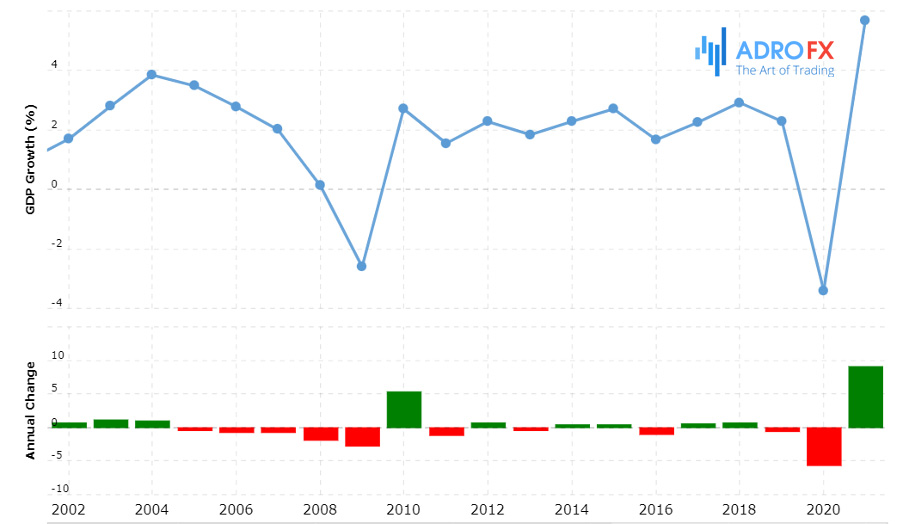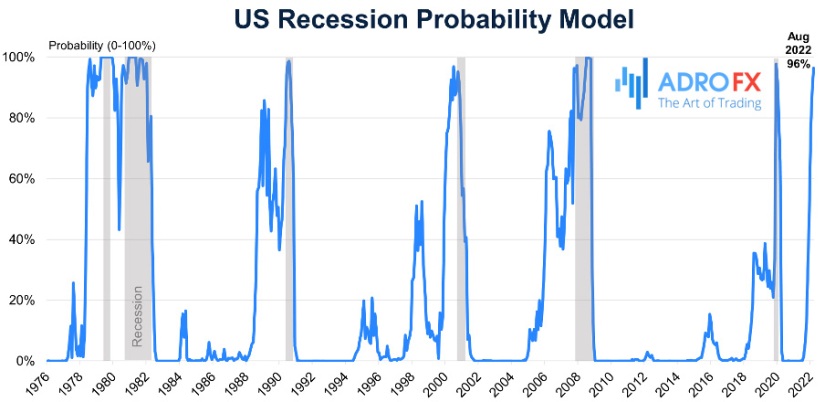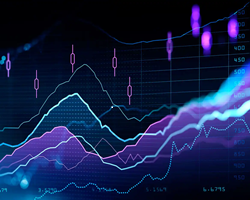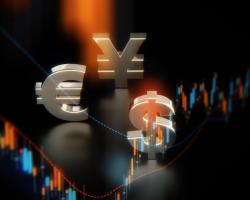What Is a Recession? Definition, Causes & Warning Signs

Economic development is cyclical – a boom is always followed by a downturn. Such a downturn is called a recession, a phenomenon that recurs with varying frequency and depth. Sometimes recessions occur with little or no serious economic disturbance, but other times they can lead to crises of varying magnitude. So what is a recession, what are its characteristics, and is the world economy in a recession now?
What is a Recession
A recession is commonly defined as a state in which there is a slowdown in economic growth (often to zero values) and a decline in most financial indicators.
The criteria for what constitutes a recession may vary slightly in individual countries. For example, the U.S. National Bureau of Economic Research defines it in a slightly more detailed way: "a recession is a decline in an economic activity affecting the entire economy, lasting more than several months, and usually affecting GDP, real income, employment, industrial production, and sales."
If the decline has been particularly deep or prolonged, one speaks not of a recession, but a full-blown crisis. In any case, consumers are particularly hard hit by the recession. Unemployment arises, causing people to make fewer purchases, and forcing businesses to cut back or close.
Economists do not consider short periods of recession to be recessions, but longer recessions are called depressions. The word depression scares people, so it was last used in the 1930s during the Great Depression.
The U.S. National Bureau of Economic Research believes that it is impossible to accurately distinguish between a short-term recession and a recession. It is not possible to clearly define periods of recession, but it is possible to define the highs and lows of economic development. A recession comes after the economy accelerates to a peak and ends when the economy sinks to a low.
Official data on recession does not appear immediately after the economy slows, but only six months to a year later. This time is needed to analyze macroeconomic indicators: gross domestic product, unemployment, housing construction rates, and others.
The average duration of an economic slowdown in the U.S. is 17.5 months. The Great Depression lasted 43 months. The longest recession since World War II lasted 18 months, from December 2007 to June 2009. Since World War II, recessions have occurred every 5.5 years.
Recessions most often lead to massive declines in stock market indices, which only makes unemployment worse - that completes the circle. Also, as a rule, the economy of one country depends on the economies of others, so an economic downturn in one country or another is very likely to lead to a downturn in other countries and even to a crash on the world stock exchanges.
But how does recession differ from stagnation? Stagnation often occurs before a recession. During stagnation, the economy does not grow, but it does not slow down either. That is, macroeconomic indicators are close to their values for previous periods.
As a rule, stagnation is associated with internal economic causes. For example, capital outflows and lower investments are preventing the industry from growing. Russia's economy is focused on exports of natural resources, so a decline in their prices also leads to stagnation.

What Causes Recession
The reasons that cause an economic downturn are individual to each state. The most common ones include the following.
The country's dependence on the export of natural resources
This makes it an "economic hostage" to the prices of traded raw materials. Any sharp downward spike can lead to a recession.
The financial crisis in other countries
The world's largest economies are the U.S. and China. The problems in these states resonate throughout the world. Everyone remembers the mortgage crisis in America in 2007-2008, which brought down the stock indices of all countries.
Also, a recession in a single state can cause problems in the partner countries. The deeper the partnership, the greater the mutual dependence.
Military conflicts
War takes a heavy toll on the economies of the countries involved. That is why it is said that there are no winners. Infrastructure is destroyed, production stops, and the flow of refugees rushes to neighboring states. Recovery can take decades. One of the causes of the Great Depression was not in vain called the First World War. Recessions after military conflicts can last for years.
Natural disasters, man-made disasters, epidemics, and other force majeure circumstances
We do not need to go far to find examples. The COVID-19 epidemic dramatically collapsed the demand for petroleum products in early 2020. People were leaving their homes less and using transport less, oil prices dropped to record lows, which could not but affect the exporting countries.
The opposite happened in September 2019 after a drone attack on an oil refinery in Saudi Arabia. Saudi oil production halved (from 9.8 million barrels to 4.1 million bpd). Prices for "black gold" jumped, hitting the pockets of importing countries.
Scientific and technological progress
Even such harmless, at first sight, factors may provoke an economic recession. At a time when new technologies are actively conquering the market, the existing equipment becomes obsolete and irrelevant. The demand for products made with old technology is declining. Not all manufacturers have an opportunity to modernize within a short period. Many are forced to close. There is also active automation in the industry. Machines are replacing manual labor, which leads to increased unemployment.
The impact of the international situation
The world's largest economies are China and the United States. The slowdown in production and consumption in each of these countries affects their partners around the world.
International trade declines during a recession because exports and imports fall. Supply chains are disrupted - bringing production to a standstill in different countries.
Shocks to the economy
Recessions often occur aftershocks to the economy. There were several such shocks in 2019. First, the trade war between the U.S. and China escalated: both countries raised tariffs on imports, and the U.S. even called China a currency manipulator. At the beginning of 2020, the US did remove China from the list of manipulators.
Simultaneously with the trade wars, the U.S. and China fought for supremacy in the high-tech sector. The U.S. announced that the Chinese company Huawei threatened the country's national security.
After the start of the coronavirus pandemic in China in December 2019, demand for petroleum products dropped sharply, with people using less transportation. Oil prices collapsed in the aftermath, a major shock to world markets.
Financial market problems
Some recessions start with financial market problems, such as credit booms. The global financial crisis of 2007 began with the mortgage boom in the United States. Borrowers were not asked for proof of income, and loans were given to anyone who wanted them. Real estate prices went up. People hoped they could make money from it, so they bought several houses at once. Private investment banks also wanted to make money - they issued mortgage bonds and risky derivatives.
But in 2006, real estate prices began to fall, and many borrowers stopped paying. A boom in high-risk mortgages in the United States led to bank failures and a prolonged global financial crisis.
To reduce the duration of the recession and minimize its negative effects, governments use various methods: most often it is quantitative easing, changes in the size of the state interest rate, control over financial transactions, and support for exporters.
Types of Recession
A recession affects the entire economy of a country. If GDP falls quickly and sharply and then recovers just as sharply, analysts call it a V-recession. If GDP falls sharply but recovers long and smoothly, it is a U-recession.
A manufacturing recession is a recession in individual industries. For example, a decline in industrial production and an associated decline in wholesale and retail sales. When demand falls, companies have the excess capacity with nothing to load. As a result, manufacturing companies' profits can fall by more than 30%.
Financial recession - a slowdown in the financial sector of the economy. Economists analyze currency and credit risks, liquidity risks, and the possibility of a banking crisis. For example, during a banking panic, many people take deposits, bank liquidity decreases, and this can lead to bank failures.
Market recession - a general economic recession, defined by a drop in macroeconomic indicators. A prolonged decline in employment and real income leads to a decrease in demand and prices.
Signs of a Recession in the Economy
If real GDP declines for two quarters in a row, economists believe a recession has set in. Real GDP is the value of all goods and services produced in the country, adjusted for inflation.
In addition to GDP, economists focus on other indicators, such as an increase in unemployment and a drop in real income. Another possible definition of a recession is a period of marked decline in production, sales, income, and employment, which usually lasts from six months to a year.
Examples of Recession
The most powerful and studied crisis was the Great Depression, which began in the United States on October 24, 1929. This recession ended a long cycle of growth after World War I.

The Great Depression was the first economic crisis on a planetary scale. Before then, the world economy as a whole simply did not exist, and in individual countries and regions, these cycles were out of sync. The Great Depression spread from the U.S. to Europe, but as if it passed over the Soviet Union. By the 1930s, the Soviet Union had already established a deeply isolated and non-market economy.
A textbook example of a less dramatic but far more prolonged recession is the lost decade in Japan in the 1990s. In turn, in 2008, the storm came from the U.S. mortgage market. Finally, we can name the greatest economic coronavirus crisis since the Great Depression of the early 2020s. A key feature of this crisis was its structural dimension. Unlike the crisis of 2008-2009, the coronavirus hit the smallest entrepreneurs and the service sector the hardest: hairdressers, cab drivers, restaurateurs, and hoteliers. Therefore, governments had to develop fundamentally different recipes to support the economy.
The Consequences of a Recession
What leads to a recession often also becomes its consequences, such as an increase in unemployment. Usually, consumption and investment spending by companies fall much more sharply than GDP declines.
Reduced corporate spending. Companies are forced to cut spending and reduce investment.
An increase in unemployment. The unemployment rate rises during recessions. In the U.S., from March 26 to April 23, 2020, people filed more than 25 million claims for unemployment benefits. During the same period in 2019, people filed just over a million applications.
Falling demand and rising debt. Overall demand for goods and services is falling because people don't have money. Debts, such as utility bills, are rising.
But how does it threaten the population? During a recession, people's real income, i.e. income minus taxes and fees and adjusted for inflation, decreases. Businesses are forced to cut jobs and wages.
Effect on the stock market. There could be a severe correction or even a full-blown bear market in the stock market because of the recession. But it could be that stocks from some sectors will fall and those from other sectors will fluctuate at the same level or even rise.
For example, during a coronavirus crisis, stocks of companies that develop a vaccine or trade products go up. And stocks of oil producers, airlines, and cruise companies go down.
Defaults are increasing - companies can't pay bond coupons on time or can't even redeem bonds because they don't have the money.
During a recession, the prices of many stocks and parts of bonds fall, so investors may be interested in expanding or changing their portfolios. But don't sell feverishly during recessions, because recessions end and stock markets make new highs afterward.
How to Get Ready for a Recession
As we said before, it is impossible to predict the recession in advance. That is why you should always be prepared for it. It is not necessary to stockpile stewed meat and buckwheat – there are much more appropriate assets.
The following tips can help you survive the recession without serious damage to your nerves and wallet.
Try to get rid of your debts. If you have outstanding loans, put all your energy into paying them off quickly. If possible, refinance your loan for a better interest rate.
Cut back on spending. If you don't keep track of your expenses, it's time to start doing so. This way you can discover and patch up holes in your budget. Avoid pointless and unnecessary expenditures; approach each purchase consciously.
Establish an emergency fund. This is the safety cushion. It will help you through hard times and relieve anxiety about the future.
Create several independent sources of income. During a recession, unemployment rises, and everyone can get laid off and lose their livelihood. Look for opportunities to feed your budget from different sources. You could, for example, learn a new profession and start a part-time job.
Recession is an inevitable process that every economy in the world goes through. So you don't have to fear it. If today your business is booming and your income is growing, it's no reason to rest on your laurels. Channel those surpluses into taking care of the future, not into mindless consumption.
What Investors Should Do During a Recession
The media often portrays recessions as "collapsing skies." However, a recession is a normal part of the economic cycle. And there is money to be made in a bear market, too.
There is no universal advice on how to make money during the recession, it depends on what kind of investor you are: some people start speculating more actively, some consider the recession as a global sell-off and buy for decades to come, and some just stop all actions and wait for the cycle to change and the market to reverse.
So we evaluate the risks, our opportunities, and our goals, and act on these data.
- Investors need to stay calm during a recession. Here's what you can do to survive the crisis with little or no loss.
Don't sell securities during a panic just because everyone is selling. Stick to your investment plan and sell only securities in heavily hit industries that are unlikely to recover quickly. In other words, sell those securities you don't believe in, but first, think about how you will dispose of the money you get from the sale.
For example, Warren Buffett in March-April 2020 sold shares of eight companies owned by his Berkshire Hathaway fund. They are 4 airlines, an oil and gas company, a bank, a financial company, and a medical company.
- Look less closely at what's going on. If you're worried about the news and falling stock prices, you should pay less attention to the situation. That way you'll worry less and reduce your chances of making bad decisions on emotion.
- Build up your investments. Recession and stock market declines are good times to buy stocks if you are willing to take risks. So, you can buy securities that have fallen in price if you previously thought they were overvalued and wanted to buy cheaper. For example, Amazon, Apple, Tesla, X5 Retail Group, and Yandex all fell 30-50% in February-March 2020, but the stability and potential of these companies have not diminished.
- Diversify your portfolio early - before the recession. If your portfolio contains stocks and bonds of many companies from different industries and countries, a long-term investor will survive the recession with little or no loss.
And to avoid depending on the situation of individual companies, you can invest in cheaper ETFs and exchange-traded equity mutual funds. This is easier than picking individual stocks and allows you to diversify your portfolio with minimal effort.
The worst assets during a recession are cyclical companies and highly leveraged assets.
Cyclical companies are highly dependent on the state of the economy, so they are best invested when economic growth is expected. And when the economy is not doing well, demand for such companies' products is low.
For example, when unemployment is high, people have little money, pay back loans less, and buy less real estate and new cars. Consequently, banks, developers, steelmakers, and automakers suffer.
How Deep the Recession May Be
The duration and depth of the recession in the U.S. depend on how stable inflation will be - and how tolerant the Fed will be of it. How badly the markets are affected depends on it as well.
Since World War II, the economy has fallen an average of 2.5 percent during recessions, with unemployment rising 3.8pc and corporate profits falling 15 percent. The average duration of a recession was 10 months.
One way to predict what a recession will be like now (if there is one) is to look at historical parallels. Many point to similarities between the current situation and the early 1980s when the Fed under Paul Volcker suppressed inflation. Others point to similarities to the energy crisis of the 1970s due to the surge in oil and food prices – and then the recession was much longer and deeper than in the 1980s.
But any historical parallels have limited utility, especially in the face of structural change. For example, inflation is not as high now as it was in Volcker's time - which means the Fed may need to raise rates less. The economy is much less energy intensive than it was in the 1970s. In 1973, it took a barrel of oil to create $1,000 of GDP (adjusted for inflation) – by 2019, that figure is down to 0.43 barrels.

That said, the real economy looks fairly stable. Household debt in the U.S. is now about 75% of the GDP (on the eve of the global financial crisis this figure was as high as 100%). Annual debt payments thanks to low rates are now about 9% of disposable income - the lowest since at least 1980. Thanks to the pandemic stimulus, excess savings are now about $2 trillion (9% of GDP).
Companies, too, look generally resilient: S&P predicts that the default rate among speculative-rated bonds will be only 6% next year (up from 12% in 2009). In 2021, the total debt of U.S. companies fell by 27%, or $250 billion - thanks to low rates, they were able to refinance liabilities on more favorable terms.
The financial system is also in better shape: bank reserves now account for 13% of assets (versus 8% in 2007). The real estate market, which we wrote about in detail here, is still in short supply despite strong price growth.
And finally, despite the decline in confidence, investors still believe in the Fed's ability to rein in inflation - which is why markets are actively responding to any signals from the regulator. Maybe that is enough to suppress inflation at the cost of a small recession.
Is There a Real Recession in the U.S. Yet?
There is a major argument going around the preliminary estimate of U.S. economic growth. For the second quarter of this year, the country's GDP declined 0.9% year-over-year, following a 1.6% decline in the first quarter. Thus, for the first half of the year, GDP declined by 1.3%.
This fits the definition of the so-called technical recession, which the media love to mention and use. However, numerous economists assure that it has little in common with the concept of a real recession, clear signs of which are lacking at the moment.

Political heavyweights from the governing Democratic Party and the White House, including Treasury Secretary Janet Yellen and President Joe Biden, were quick to express their views. Fed Chairman Jerome Powell, a Republican, was also cautious, noting that the data were just a preliminary estimate and would be reviewed many times over.
His party, on the other hand, reacted instantly and dubbed the current economic dynamics a Joe Biden recession. Yes, it would seem that the purely economic debate quickly escalated to the status of a political confrontation. And for good reason, as the November 8 elections for the U.S. Congress are approaching.
Who and How Diagnoses the U.S. Economy?
In reality, it is almost impossible to quickly determine the onset of a recession. And most often it can be done several months later after sufficient verified macroeconomic data is available. The National Bureau of Economic Research was appointed as the official arbiter of recession in the United States. A special committee of eight economists from this organization meets behind closed doors after a considerable period following the first statistical signals. This interval can take several months or even a year.
It is the Bureau that defines a recession as "a significant decline in economic activity that extends throughout the economy and lasts for more than several months, usually visible in production, employment, real income, and other indicators."
So far, some key economic indicators are not at all indicative of an impending recession. This is especially true for the U.S. jobs market: the economy continues to create jobs at a brisk pace and the unemployment rate stands at 3.6% - a figure close to five-year lows. At the same time, signs of economic cooling are also present: consumer demand has slowed markedly, and investment and private business spending have declined.
However, even if there are few signs of recession now, there are no guarantees that the situation will not change shortly. If inflation remains high, it will continue to weigh on demand. Moreover, in this case, the Fed will be forced to intensify the fight against this inflation - first of all, to raise rates even more decisively.
That is when one of the current major fears of the markets could materialize, that the U.S. central bank could "overreact" in its harsh actions and provoke a significant economic downturn. Right now, senior officials at the Fed itself are cautiously optimistic, but the further one goes, the more they admit that the risks of such a scenario are growing.
Implications for Financial Markets in 2022
What the mere threat of recession means for financial markets could be seen in recent months, when many analyst institutions sharply increased the likelihood of a recession in 2022-23 to 50%: only in last three months the leading U.S. stock indices S&P 500 and Nasdaq Composite dropped more than 15%

Moreover, prices of all market assets, including commodities, fell precipitously. Even U.S. Treasuries and gold, traditionally considered the safest safe havens for investment, suffered.
For Ukraine, in its predicament at war, the state of global financial markets matters far less than in peacetime, because the country is almost entirely dependent on the support of its Western allies and international financial institutions. However, a recession could also seriously complicate this support, as the West will have to be more distracted by its economic problems.










